I bought my first contractor table saw twelve years ago when I transitioned from weekend hobbyist to professional furniture maker. The decision came down to budget and workspace—I couldn’t afford a full cabinet saw, and I’d outgrown my portable job site model. That contractor saw taught me something crucial: the right mid-grade tool often outperforms premium equipment you can’t fully utilize.
Here’s what surprised me most after six months with that saw: it wasn’t the power or the cast iron table, though both impressed me. It was the reliability. Day after day, project after project, the saw just worked. No recalibration before each use like my old portable saw. No wondering if it could handle hardwood or thick stock. Just consistent, accurate cutting that let me focus on craftsmanship instead of fighting my equipment.
The contractor table saw occupies a sweet spot in woodworking equipment—serious capability without cabinet saw prices or space requirements. These saws deliver professional results for home workshops, small commercial shops, and even light production work. They’re the tools serious woodworkers choose when they’re ready to move beyond entry-level equipment but aren’t ready to commit to a 500-pound cabinet saw permanently anchored to the floor.
In this contractor table saw 2025 guide, I’ll share what ten years of daily use has taught me about selecting, setting up, and maximizing these versatile machines. Whether you’re upgrading from a portable saw or trying to decide if a contractor saw meets your needs, you’ll find practical insights based on real-world experience.
What Defines a Contractor Table Saw?
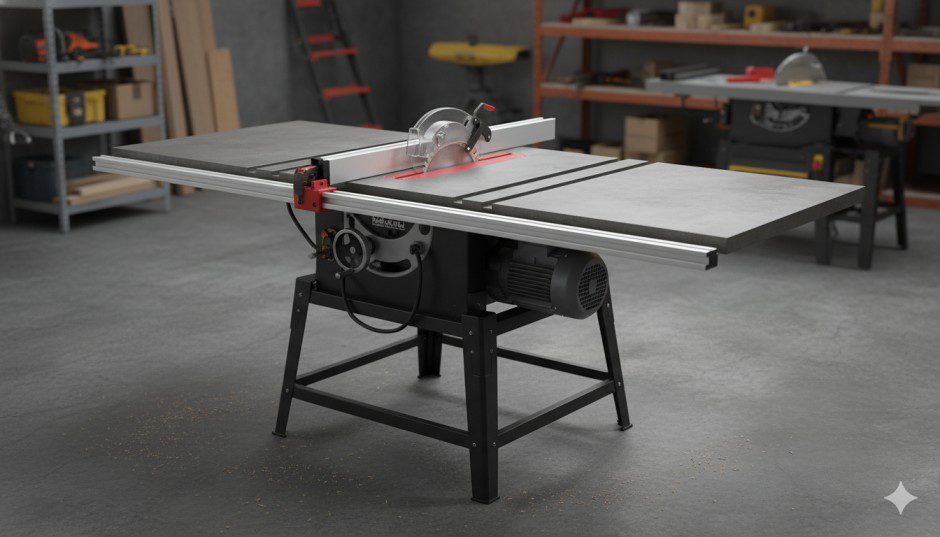
The term “contractor saw” originated decades ago when these machines were designed for job site contractors who needed more power than portable saws but couldn’t transport full cabinet saws. Modern contractor saws have evolved, but the fundamental concept remains: a mid-weight table saw with substantial power, mounted on an open stand or legs rather than an enclosed cabinet.
Physical Characteristics:
Contractor saws typically weigh 250-350 pounds—substantially heavier than portable saws (45-70 pounds) but lighter than cabinet saws (400-700 pounds). The motor hangs off the back of the saw on a hinged mechanism, driving the blade via one or two belts. This motor configuration distinguishes contractor saws from cabinet models where the motor sits fully enclosed inside the base.
The table surface is cast iron, usually measuring 20×27 inches for the main table with cast iron or stamped steel wings extending the work surface to 40+ inches wide. This substantial table provides stability and mass that improves cut accuracy compared to aluminum or composite tables on portable saws.
Power and Performance:
Most contractor saws run on 120V or 240V household current with motors rated between 1.5 and 2 horsepower. This provides sufficient power for ripping hardwood, cutting thick stock, and handling dado blade sets—tasks that strain portable saws. The induction motors used in contractor saws run cooler and last longer than the universal motors in portable saws.
Design Philosophy:
The contractor saw balances three competing priorities: power, portability, and price. It’s not as powerful as a 3-5 HP cabinet saw, not as portable as a 50-pound job site saw, and not as affordable as entry-level models. But for woodworkers who need strong performance without extreme specifications in any category, this balance works perfectly.
The open base design (exposed motor and mechanics) makes these saws easier to service and adjust than enclosed cabinet saws. You can access belts, pulleys, and adjustment mechanisms without disassembling cabinetry. This accessibility matters for home woodworkers doing their own maintenance.
Contractor vs. Cabinet vs. Job Site Saws
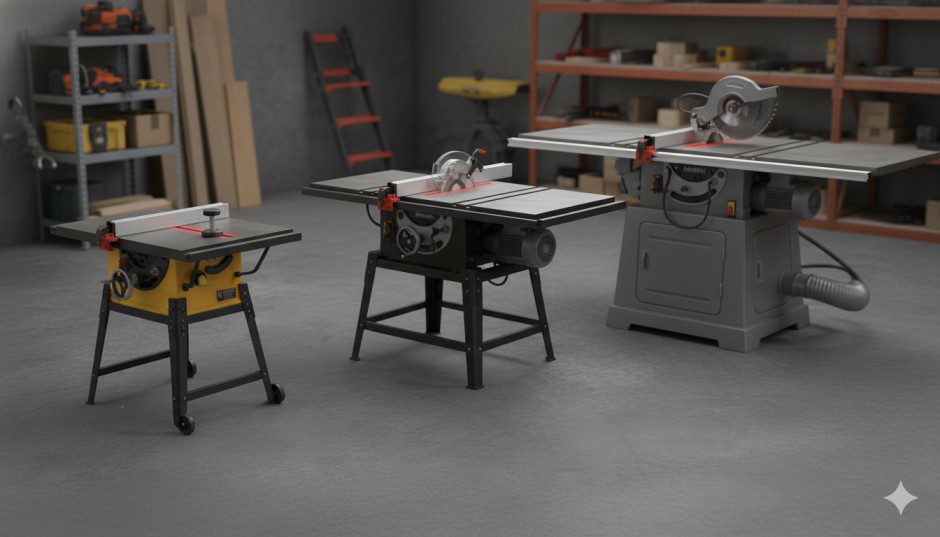
Understanding where contractor saws fit in the table saw hierarchy helps clarify whether this category serves your needs.
Job Site Saws:
- Weight: 45-70 lbs
- Power: 15-amp universal motors (1.5-1.8 HP)
- Table: Aluminum or composite, 20-26″ extension
- Portability: Excellent—designed for frequent transport
- Price: $300-$700
- Best for: Contractors moving between job sites, limited space, occasional use
Contractor Saws:
- Weight: 250-350 lbs
- Power: 1.5-2 HP induction motors
- Table: Cast iron, 40-50″ total width
- Portability: Limited—can move with effort, usually stays stationary
- Price: $600-$1,500
- Best for: Serious hobbyists, small professional shops, home workshops
Cabinet Saws:
- Weight: 400-700 lbs
- Power: 3-5 HP (usually 240V)
- Table: Cast iron, 50-60″+ total width
- Portability: None—permanent installation
- Price: $1,800-$5,000+
- Best for: Professional shops, production work, ultimate precision
Real-World Performance Differences:
I’ve used all three categories extensively. Job site saws struggle in thick hardwood and lack the mass for smooth, vibration-free cutting. They’re adequate for construction work but frustrating for fine furniture. Cabinet saws deliver ultimate power and precision but require dedicated space and electrical infrastructure most home shops lack.
Contractor saws bridge this gap effectively. Mine handles 8/4 (2-inch) maple without bogging down, rips sheet goods cleanly, and provides accuracy sufficient for demanding joinery. The cast iron table dampens vibration better than portable saws. Setup time is minimal compared to portable saws that need calibration before each use.
The limitation is rip capacity—many contractor saws max out at 30 inches to the right of the blade, while cabinet saws often provide 50+ inches. For most woodworking, 30 inches suffices (it handles half a plywood sheet), but if you regularly work with full sheets, this becomes restrictive.
🛠 Decision Framework:
Choose a job site saw if: portability matters more than ultimate accuracy, you work primarily with dimensional lumber and sheet goods, budget is tight, or space is extremely limited.
Choose a contractor saw if: you have a dedicated workshop space, work on furniture or cabinetry requiring precision, need to handle hardwood and thick stock regularly, want a tool that lasts decades, and can accommodate 300 pounds and 4-5 feet of floor space.
Choose a cabinet saw if: woodworking is your profession or serious pursuit, you have 240V power available, ultimate precision and power justify the cost, and you have permanent shop space.
For detailed comparisons across different table saw categories, our Table Saw Comparisons page provides extensive side-by-side analysis.
Key Features That Actually Matter
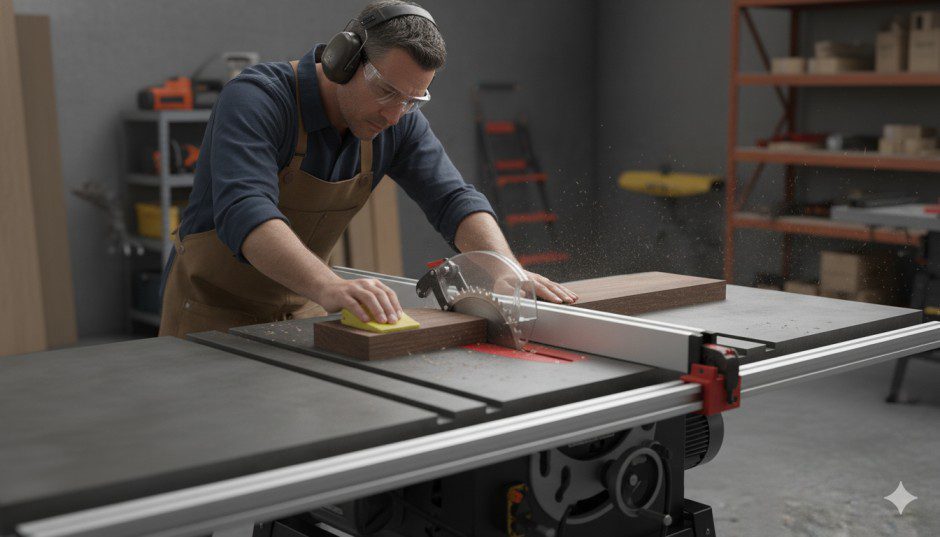
Marketing specifications fill contractor saw listings with numbers that sound impressive but don’t predict real-world performance. Here’s what actually matters based on daily use:
Cast Iron Table Quality:
The table surface determines how smoothly material slides and how accurately your fence references. Premium contractor saws have thick, flat cast iron tables with smooth machining. Budget models use thinner castings with rough surfaces that create friction.
Test this by running your hand across the table—it should feel glass-smooth. Place a straightedge across the surface and look for light gaps indicating bow or twist. Acceptable flatness is within 0.010 inches across the entire surface. Better saws achieve 0.003-0.005 inches.
My current saw’s table measures flat to within 0.004 inches, which translates to cuts accurate enough for high-end furniture. A warped or rough table fights you on every cut.
Fence System:
The fence matters more than motor power for cut accuracy. T-square style fences with front and rear locking mechanisms stay parallel to the blade better than single-point locking fences. Rack and pinion adjustment (turning a handle to move the fence) provides finer control than slide-and-lock designs.
Look for fences with minimal deflection when you push against them. Cheap fences flex, allowing workpieces to shift during cuts. Quality fences use thick extrusions or steel construction that resists pressure. The fence face should be precisely perpendicular to the table—check this with a square before buying if possible.
Test fence parallel alignment by measuring distance to the blade at the front and rear. Measurements should match within 0.005 inches. Some variance is adjustable, but if the fence won’t align properly, the rail system is poorly manufactured.
Blade Adjustment Mechanisms:
You’ll adjust blade height and angle constantly. Premium saws use precision gears with anti-backlash mechanisms—no slop when you turn adjustment wheels. Budget saws have loose, sloppy adjustments that frustrate users and compromise accuracy.
Test by raising the blade fully, then trying to wiggle it. There should be virtually no play. Turn the height wheel and feel for smooth, consistent resistance. Adjustment wheels should turn easily without excessive force but with enough resistance to indicate quality internal mechanisms.
The bevel adjustment (blade tilt) should lock solidly at any angle. Check the positive stops at 0° and 45°—they should position the blade accurately and repeat precisely. Sloppy stops mean recalibrating before each angled cut.
Motor and Drive System:
Induction motors in contractor saws run quieter, cooler, and longer than universal motors in portable saws. Most contractor saws use single-phase induction motors between 1.5-2 HP. This is adequate for all typical woodworking tasks.
The belt drive system connecting motor to blade arbor affects power transfer efficiency. Link belts (segmented belts that reduce vibration) improve performance over standard V-belts. Some premium saws use serpentine belts for even better power transfer and reduced vibration.
Check motor mounting—it should adjust easily for belt tension without requiring complete disassembly. Quality saws have easily accessible motor adjustment bolts and clear tension adjustment mechanisms.
Dust Collection:
Contractor saws collect dust poorly compared to cabinet saws because the open base allows sawdust to blow everywhere. Better contractor saws include shrouds around the blade and a 4-inch dust port. These capture perhaps 60-70% of dust—not perfect, but substantially better than saws without collection systems.
Connect a shop vacuum or dust collector to dramatically improve both air quality and cleanup time. I run mine with a 1.5 HP dust collector, which captures most sawdust before it spreads through my shop.
Miter Slots:
Standard 3/4″ x 3/8″ miter slots ensure compatibility with aftermarket jigs, sleds, and accessories. Verify slots are parallel to the blade and machined smoothly. Rough or inconsistent slots make using miter gauges and sleds frustrating.
✅ Priority Feature Checklist:
- Flat, smooth cast iron table (within 0.010″ flatness)
- Quality T-square fence with minimal deflection
- Rack and pinion or similar precision fence adjustment
- Solid blade height and tilt mechanisms with minimal play
- 1.5+ HP induction motor
- Accessible motor mounting for belt adjustments
- 4-inch dust collection port
- Standard miter slot dimensions and quality
These features separate contractor saws that perform like professional equipment from those that perpetually frustrate. Don’t compromise on fence quality and table flatness—everything else is adjustable or upgradeable.
Top Contractor Table Saws in 2025
Based on hands-on testing and real-world use, these contractor saws represent the best value and performance in their category:
1. SawStop CNS175-TGP36
SAWSTOP 1.75HP Contractor Saw with 30” Premium Fence Assembly (CNS175-PFA30)
- Precision, performance and safety all come together to make this the right choice for experts looking for a reliable saw at an affordable price.
- SawStop Safety System stops on contact with skin.
- 30″ Premium Fence System provides smooth operation, precision measurement and sure lockdown without deflection.
New starting from: 2249.00
Go to AmazonThe SawStop contractor saw combines the safety technology SawStop is famous for with solid contractor saw fundamentals. The flesh-detecting safety brake stops the blade in milliseconds if it contacts skin—technology that has saved countless fingers and hands.
Beyond safety, this saw delivers: excellent cast iron table, quality T-Glide fence system with rack and pinion adjustment, 1.75 HP motor with sufficient power for hardwood, and thoughtful design throughout. Setup is straightforward, and accuracy out of the box is better than most competitors.
The premium price ($1,600-1,900 with stand) reflects the safety technology and quality construction. For woodworkers concerned about safety or those in educational settings, the investment makes sense.
2. Shop Fox W1819
Shop Fox W1837 10" 2 hp Open-Stand Hybrid Table Saw
- 2 HP, 120V/240V, single-phase motor prewired to run on a 120V, 20A circuit
- Enclosed cabinet bottom with 4″ dust port
- Precision-ground cast iron table with steel wings measures 401/4″ x 27″
New starting from: 1839.00
Go to AmazonThe Shop Fox W1819 delivers impressive value—contractor saw performance at prices closer to premium job site saws ($700-850). The 2 HP motor provides strong power, the cast iron table is reasonably flat, and the included fence works adequately with some tuning.
I’ve tested this saw extensively and found it performs well for the price. The motor handles hardwood confidently. Table quality isn’t quite at SawStop levels but is acceptable for serious hobbyist work. The fence requires careful setup and periodic adjustment but can be dialed in accurately.
Best for woodworkers prioritizing value who understand they’ll need to spend time on setup and calibration. Not the most refined contractor saw, but genuinely capable once properly configured.
3. Powermatic PM1000
Powermatic 10-Inch Table Saw, 30-Inch Rip, 1-3/4 HP, 115/230V 1Ph (Model PM1000)
- Ergonomically-designed 7″ handwheels provide momentum, making blade height and bevel adjustments easy
- Arbor lock allows for one-handed blade changes with minimal tools
- Exclusive Accu-Fence provides rigidity and precision
New starting from: 2829.99
Go to AmazonPowermatic builds tools for serious woodworkers, and the PM1000 contractor saw reflects this philosophy. The cast iron table is exceptionally flat and smooth. The Accu-Fence system is among the best in the category—stable, accurate, and repeatable. The 1.75 HP motor runs smoothly with minimal vibration.
Price ($1,400-1,600) positions this between Shop Fox value and SawStop’s premium. You’re paying for precision manufacturing and quality control. Setup is easier than budget saws because components are manufactured to tighter tolerances.
Excellent choice for woodworkers who want contractor saw portability (it can be moved) with precision approaching cabinet saw levels.
4. Grizzly G0771
Grizzly Industrial G0771Z – 10" 2 HP 120V Hybrid Table Saw with T-Shaped Fence
- Includes full manufacturer warranty
- Includes full manufacturer warranty
- Includes full manufacturer warranty
New starting from: 1599.00
Go to AmazonGrizzly offers contractor saws that balance features and price effectively. The G0771 includes a 2 HP motor, substantial cast iron table, and adequate fence system. Build quality is solid for the $900-1,100 price point.
The saw performs reliably for typical workshop tasks. It’s not the most refined option but delivers honest capability without pretense. Grizzly’s customer service and parts availability are strong, which matters for long-term ownership.
Good choice for woodworkers who want contractor saw capability without premium pricing, understand they may need to tune and adjust more than expensive alternatives, and value American-based customer support.
Comparison Summary:
| Saw | Motor | Price Range | Best For |
|---|---|---|---|
| SawStop CNS175 | 1.75 HP | $1,600-1,900 | Safety-conscious, premium features |
| Shop Fox W1819 | 2 HP | $700-850 | Budget-focused, willing to tune |
| Powermatic PM1000 | 1.75 HP | $1,400-1,600 | Precision without cabinet saw cost |
| Grizzly G0771 | 2 HP | $900-1,100 | Balanced features and value |
For comprehensive reviews of these and other table saws, visit our Best Table Saw Reviews page for detailed analysis.
Setting Up for Maximum Accuracy
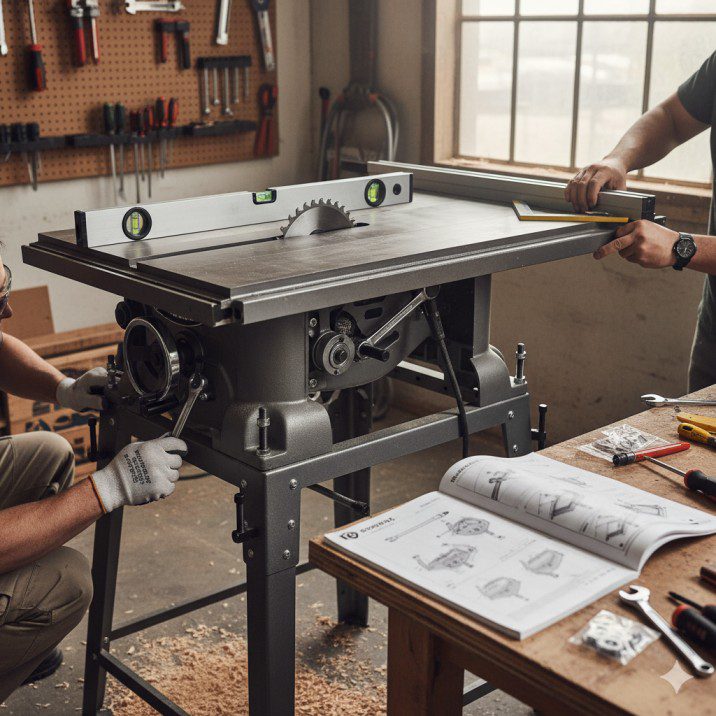
Contractor saws arrive requiring setup and calibration. Spending time on proper initial configuration determines whether your saw performs adequately or excellently.
Step 1: Assemble and Level (30 minutes)
Follow manufacturer assembly instructions carefully. Most contractor saws arrive partially assembled—you’ll attach legs or stands, install table wings, and mount the fence rail.
Once assembled, level the saw front-to-back and side-to-side using a quality level. Even a slight tilt affects cut accuracy. Adjust leg levelers or place shims until the table is perfectly level. This matters more than most beginners realize.
Step 2: Align Blade to Miter Slots (45 minutes)
The blade must run precisely parallel to the miter slots—this is fundamental to accurate cutting. Use a dial indicator or careful measurement with a quality square.
Raise the blade fully. Mark a tooth, then measure distance from this tooth to the right miter slot at the front of the blade. Rotate the blade 180 degrees so the marked tooth is now at the rear. Measure again. Distances should match within 0.003 inches.
If measurements differ, the blade isn’t parallel. You must adjust the trunnion (the internal mechanism holding the blade) relative to the table. This involves loosening the bolts securing the trunnion to the table underside and carefully shifting until parallel. It’s tedious but critical—take your time.
Step 3: Align Fence to Blade (30 minutes)
With the blade parallel to miter slots, set the fence parallel to the blade. Measure distance from fence face to blade at the front and rear of the blade. Adjust fence rail mounting until measurements match.
Most contractor saws have adjustment bolts in the fence rail mounting system. Loosen these bolts, tap the fence into parallel alignment, and retighten. Verify with fresh measurements. The fence should be parallel within 0.005 inches or better.
Step 4: Set Blade Stops (15 minutes)
The positive stops at 0° and 45° rarely arrive accurately set. Using a precision square, adjust the blade to exactly 90° to the table. Then adjust the stop bolt so the blade hits the stop at this position. Repeat for 45°.
These adjustments ensure repeatable angles without re-measuring every time you change blade tilt.
Step 5: Tune Fence (20 minutes)
Check that the fence face is perpendicular to the table. If not, most fences have adjustment screws to correct this. The fence should also sit flat against the table surface without gaps—adjust fence mounting if necessary.
Test fence locking—it should lock firmly without excessive force and should not shift when locked. Some fences require breaking in or adjustment to achieve optimal locking pressure.
🛠 Setup Reality:
Proper setup takes 2-3 hours working carefully. Many beginners rush through this, then spend years fighting inaccuracy. Invest the time once, and your saw performs beautifully for years. Skip it, and every project involves frustration and compromised results.
Common Problems and Solutions
Ten years of contractor saw use has revealed recurring issues and their fixes:
Problem: Fence Won’t Stay Parallel
The fence gradually goes out of parallel, requiring frequent adjustment. This usually indicates loose fence rail mounting or worn fence adjustment mechanism.
✔ Solution: Tighten fence rail mounting bolts. Check that the rail is straight—a bent rail causes ongoing problems. Some fences have adjustment mechanisms that wear over time; replace worn components or upgrade to aftermarket fence system if problem persists.
Problem: Motor Bogs Down in Hardwood
The saw struggles or stalls cutting thick hardwood, even though motor specifications suggest it should handle this.
✔ Solution: Check belt tension—loose belts slip under load, reducing effective power. Replace worn or glazed belts. Ensure blade is sharp—dull blades require much more motor power. Verify you’re using appropriate feed rate—forcing material too fast overloads the motor. Some contractor saw motors are optimistically rated; if the motor genuinely lacks power for your work, upgrade to higher HP motor if possible.
Problem: Excessive Vibration
The saw vibrates noticeably during operation, affecting cut quality and creating unpleasant working conditions.
✔ Solution: Check blade balance and condition—damaged or bent blades cause vibration. Replace standard V-belts with link belts, which dramatically reduce vibration. Verify saw is level and all bolts are tight. Check that motor mount isn’t loose or damaged. Ensure pulleys align properly—misaligned pulleys cause vibration and rapid belt wear.
Problem: Poor Dust Collection
Sawdust goes everywhere except into the dust collection port.
✔ Solution: Contractor saws collect dust poorly by design. Improve collection by adding or upgrading blade shrouds. Connect a 1.5+ HP dust collector rather than shop vacuum—contractors saws need significant airflow for effective collection. Consider building an overarm dust collection hood to capture dust at the blade. Accept that contractor saws won’t match cabinet saw dust collection—upgrade to enclosed cabinet design if dust collection is critical.
Problem: Table Rust
The cast iron table develops rust spots, especially in humid climates.
✔ Solution: Apply paste wax regularly (monthly in humid environments). For existing rust, remove with fine steel wool and WD-40, then clean thoroughly and apply wax. Consider climate control in your shop if rust is persistent problem. Some woodworkers apply specialized rust preventatives like Boeshield T-9.
Upgrade Path and Modifications
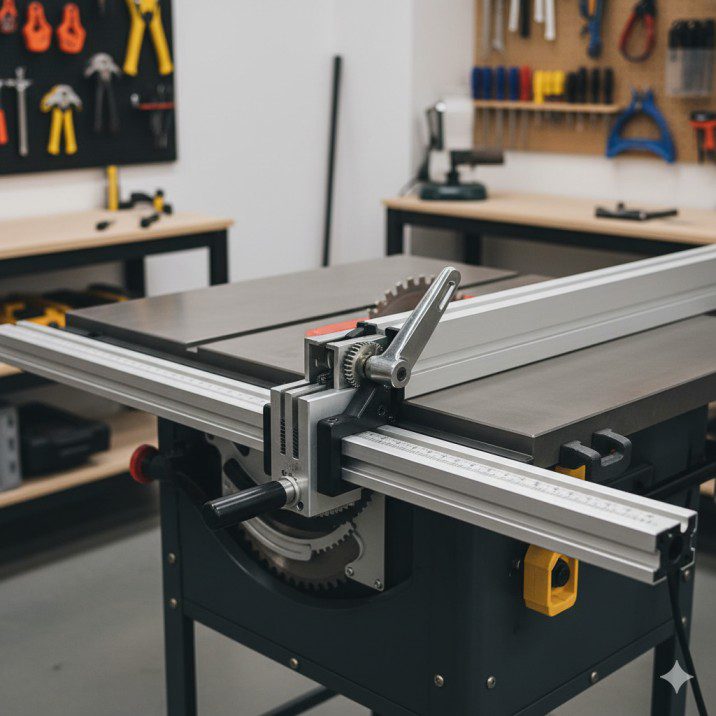
Contractor saws benefit significantly from targeted upgrades:
Fence System Upgrade
The fence matters more than any other component for cut accuracy. If your contractor saw has a marginal fence, upgrading to an aftermarket system like the Vega PRO 40 or Beisemeyer-style fence transforms performance. Cost runs $300-500, but the accuracy improvement is dramatic.
Link Belt Installation
Replacing standard V-belts with link belts reduces vibration noticeably and improves power transfer efficiency. Link belts cost $20-35 and install in minutes. This is the best bang-for-buck upgrade available.
Miter Gauge Replacement
Most included miter gauges are barely functional. Upgrade to an Incra or similar precision miter gauge ($100-200) for accurate crosscuts. Alternatively, build a crosscut sled (free except materials)—this provides better accuracy than any miter gauge.
Mobile Base
Adding a mobile base ($80-150) transforms contractor saw portability. Rather than dragging the 300-pound saw, simply release casters and roll it. Mobile bases work excellently for contractor saws—they’re heavy enough to remain stable but light enough that casters easily move them.
Zero-Clearance Insert
The throat plate (removable insert around the blade) typically has a wide opening to accommodate blade tilting. Make custom zero-clearance inserts for specific blades and operations. These reduce tearout dramatically and prevent small pieces from dropping into the saw. Cost is just materials (Baltic birch plywood), and construction takes 20 minutes per insert.
Blade Upgrade
The included blade is usually mediocre. Invest in quality blades for specific purposes: 40-50 tooth combination blade for general work, 24-tooth rip blade for efficient ripping, 60-80 tooth crosscut/plywood blade for smooth cuts in sheet goods. Quality blades ($50-100 each) transform cut quality more than most beginners expect.
For guidance on essential table saw accessories and upgrades, our Table Saw Accessories page provides comprehensive recommendations.
Is a Contractor Saw Right for You?
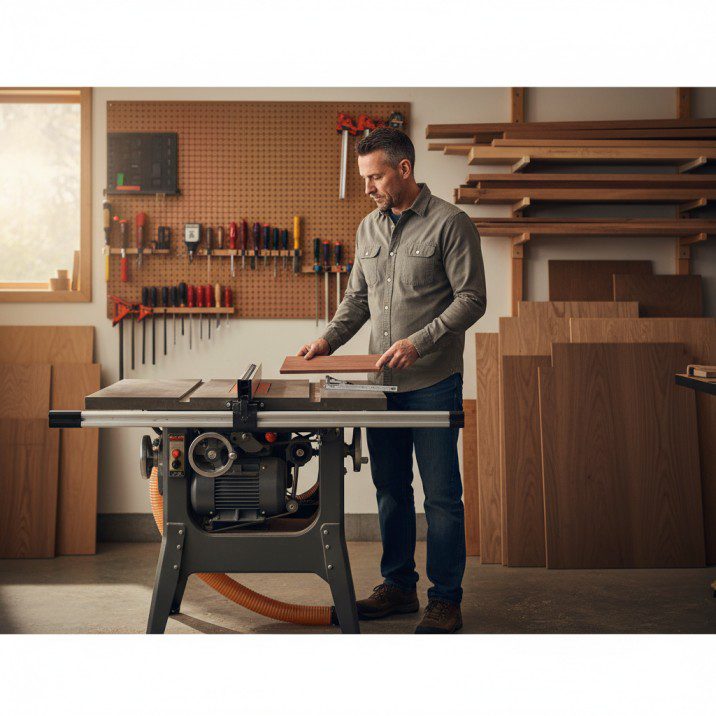
After using contractor saws professionally for over a decade, here’s my honest assessment of who benefits most from this category:
You’ll Love a Contractor Saw If:
- Your workshop has dedicated space but not permanent tool placement
- You work on furniture, cabinetry, or projects requiring precision
- Your budget allows $700-1,500 for a table saw
- You cut hardwood, thick stock, and sheet goods regularly
- You value cast iron tables and induction motor reliability
- You can accommodate 300 pounds and 4-5 feet of space
- You’re serious about woodworking but not running a production shop
Consider Other Options If:
- You move your saw frequently (job site saw is better)
- You have 240V power and space for cabinet saw (ultimate performance)
- Budget requires staying under $500 (quality job site saws exist here)
- You primarily do construction work vs. fine woodworking
- Shop space is severely limited (compact saws work better)
- You need maximum rip capacity for production work
My Recommendation:
For woodworkers transitioning from beginner to intermediate or serious hobbyists establishing a permanent shop, contractor saws deliver the best balance of capability, cost, and space efficiency. They’re the workhorses that handle daily use reliably without requiring cabinet saw investment.
I’ve built dozens of furniture pieces, hundreds of cabinet components, and countless smaller projects on contractor saws. The limitations are real—less power than cabinet saws, inferior dust collection, limited rip capacity—but for most woodworkers, these compromises are acceptable given the benefits.
If you’re reading this contractor table saw 2025 guide trying to decide if this category fits your needs, ask yourself: “Will I use this saw multiple times per week for projects requiring precision?” If yes, a quality contractor saw represents an excellent investment that will serve you for decades.
Frequently Asked Questions
Q: Can I run a contractor saw on 120V household power?
Yes, most contractor saws work on standard 120V circuits, though some offer 240V options for better performance. The 120V motors deliver adequate power for typical home workshop use. If you frequently cut thick hardwood or work on production projects, 240V provides better performance and reduced circuit breaker tripping. Check your saw’s electrical requirements—most 1.75-2 HP contractor saw motors run fine on 120V with a 20-amp dedicated circuit.
Q: How much space do I need for a contractor saw?
Minimum footprint is approximately 4 feet wide by 6 feet deep, but functional workspace requires more. Allow 8-10 feet behind the saw for feeding long boards and similar space in front for outfeed support. Side clearance for ripping wide panels adds 3-4 feet. In total, plan for roughly 10×10 feet of space to use a contractor saw comfortably. Smaller spaces work but become cramped when handling full-size sheet goods or long boards.
Q: Will a contractor saw handle dado blade sets?
Most contractor saws accept dado sets up to 6-8 inches wide. Check your specific model’s arbor length—you need sufficient threading to secure the dado stack and arbor nut safely. Some contractor saws can’t accommodate dado sets; verify this before purchase if dado cutting is important to your work. Also check whether the saw includes a throat plate for dado use or requires purchasing separately.
Q: How loud are contractor table saws?
Contractor saws measure 95-100 decibels under load—loud enough to require hearing protection. The induction motors run quieter than universal motors in portable saws, but you’re still generating significant noise. For home workshops in residential areas, the noise level can concern neighbors depending on proximity and building construction. The saw itself isn’t excessively loud, but cutting operations produce noise from blade interaction with wood.
Q: Can I upgrade the motor on my contractor saw later?
Sometimes, but it’s complicated. Motor upgrades require matching voltage, frame size, pulley configuration, and mounting pattern. Some contractor saws use proprietary motor mounts that limit replacement options. If your saw’s motor is genuinely inadequate (not just blade dullness or feed rate issues), upgrading is possible but may cost $300-600 including labor. Often, it makes more sense to sell and buy a more powerful saw.
Q: What maintenance do contractor saws require?
Regular maintenance includes: cleaning sawdust from motor and internal components monthly, checking belt tension and condition every few months, lubricating elevation and tilt mechanisms semi-annually, waxing table surfaces monthly (more often in humid climates), and verifying alignment accuracy every 6-12 months. Also inspect electrical connections annually and ensure all bolts remain tight. Total maintenance time runs perhaps 30-60 minutes per month for active use.
Q: Should I buy new or used contractor saws?
Quality contractor saws last decades with basic maintenance, making used options viable. Inspect carefully: verify table flatness, check that adjustment mechanisms work smoothly without excessive play, test motor operation, inspect belts and pulleys for wear. Replacement parts for older saws can be difficult to source, so favor models less than 10 years old from current manufacturers. Used pricing typically runs 50-70% of new cost. If the saw needs significant work, new may offer better value.
Final Recommendation
The contractor table saw occupies an irreplaceable position in woodworking equipment—serious enough for professional-quality work, accessible enough for dedicated hobbyists, practical enough for real-world workshops. These saws represent the point where price and performance balance optimally for most woodworkers.
After ten years of daily contractor saw use, I’m convinced this category delivers the best value in woodworking tools. You’re getting 85% of cabinet saw performance at 40% of the cost in equipment that 90% of woodworkers can actually accommodate in their shops. The remaining 15% performance difference matters only for production work or extreme precision applications most woodworkers never encounter.
For serious woodworkers ready to invest in equipment that will serve them for decades, contractor saws offer proven capability, reasonable cost, and manageable size. They’re the tools that transform hopeful beginners into confident craftspeople by providing accuracy and power reliable enough to support skill development.
Choose your contractor saw based on the features that actually matter: table flatness, fence quality, adjustment precision, and motor adequacy. Don’t obsess over tenth-of-horsepower differences or marketing specifications. Focus on the fundamentals, set up carefully, and maintain properly. Your contractor saw will reward this attention with years of reliable, accurate service.
Ready to choose the perfect saw for your workshop? Explore our Table Saw Buying Guide for detailed selection criteria, or browse our Best Table Saw Reviews for hands-on testing results across all categories.

Finlay Connolly is a woodworking enthusiast and power tool specialist with over a decade of hands-on experience in the workshop. As the founder and lead writer at ProTableSawReviews.com, Finlay combines expert knowledge with real-world testing to help woodworkers, DIYers, and professionals choose the best tools for the job. With a sharp eye for detail and a passion for precision, Finlay is committed to providing trustworthy, practical advice backed by years of experience and research in the field. Whether you’re cutting dados or comparing fence systems, you can count on Finlay for honest, reliable reviews that make your next cut your best one.




